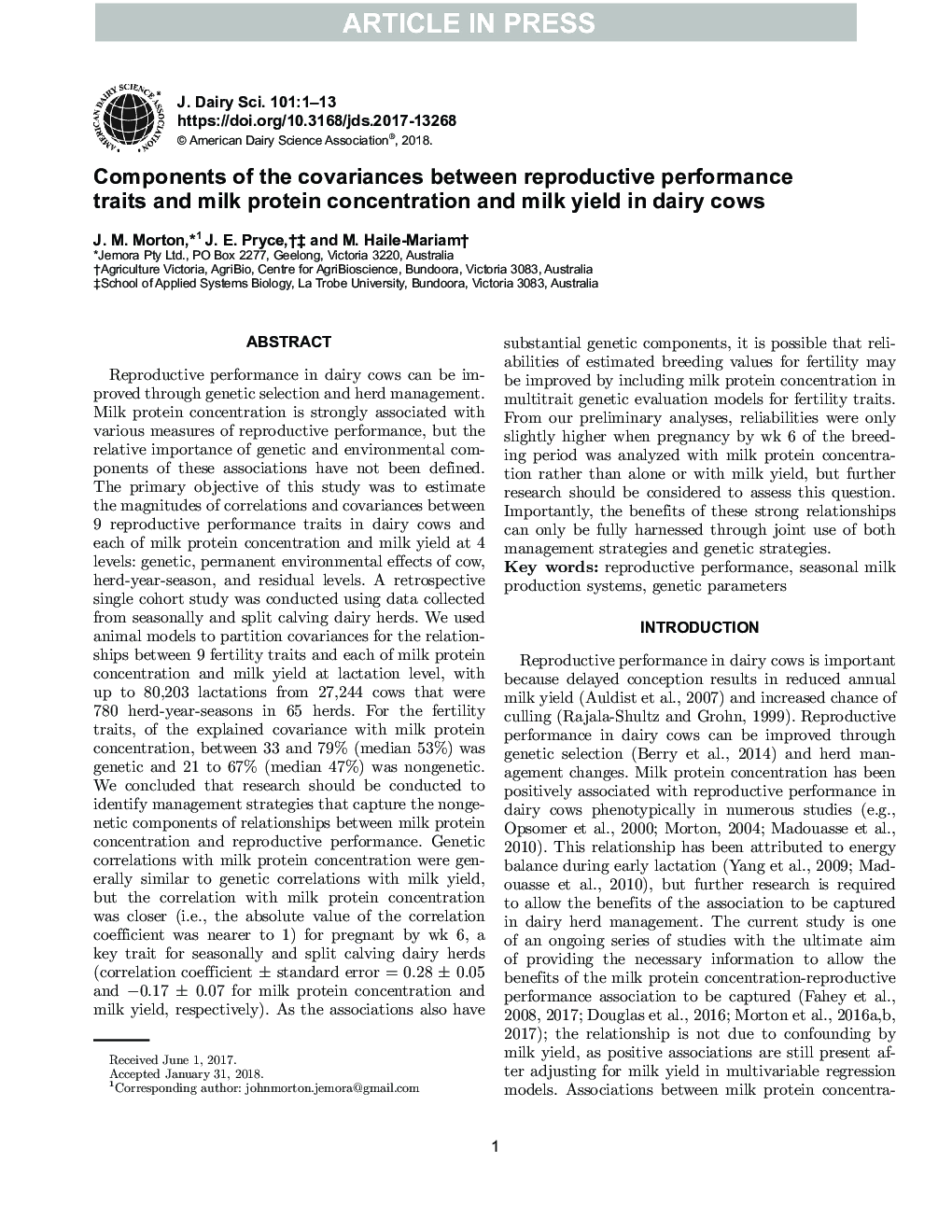| کد مقاله | کد نشریه | سال انتشار | مقاله انگلیسی | نسخه تمام متن |
|---|---|---|---|---|
| 8501144 | 1553839 | 2018 | 13 صفحه PDF | دانلود رایگان |
عنوان انگلیسی مقاله ISI
Components of the covariances between reproductive performance traits and milk protein concentration and milk yield in dairy cows
ترجمه فارسی عنوان
اجزای کوواریانس بین صفات عملکرد باروری و غلظت پروتئین شیر و تولید شیر در گاوهای شیری
دانلود مقاله + سفارش ترجمه
دانلود مقاله ISI انگلیسی
رایگان برای ایرانیان
کلمات کلیدی
عملکرد تولید مثل، سیستم تولید شیر فصلی، پارامترهای ژنتیکی،
موضوعات مرتبط
علوم زیستی و بیوفناوری
علوم کشاورزی و بیولوژیک
علوم دامی و جانورشناسی
چکیده انگلیسی
Reproductive performance in dairy cows can be improved through genetic selection and herd management. Milk protein concentration is strongly associated with various measures of reproductive performance, but the relative importance of genetic and environmental components of these associations have not been defined. The primary objective of this study was to estimate the magnitudes of correlations and covariances between 9 reproductive performance traits in dairy cows and each of milk protein concentration and milk yield at 4 levels: genetic, permanent environmental effects of cow, herd-year-season, and residual levels. A retrospective single cohort study was conducted using data collected from seasonally and split calving dairy herds. We used animal models to partition covariances for the relationships between 9 fertility traits and each of milk protein concentration and milk yield at lactation level, with up to 80,203 lactations from 27,244 cows that were 780 herd-year-seasons in 65 herds. For the fertility traits, of the explained covariance with milk protein concentration, between 33 and 79% (median 53%) was genetic and 21 to 67% (median 47%) was nongenetic. We concluded that research should be conducted to identify management strategies that capture the nongenetic components of relationships between milk protein concentration and reproductive performance. Genetic correlations with milk protein concentration were generally similar to genetic correlations with milk yield, but the correlation with milk protein concentration was closer (i.e., the absolute value of the correlation coefficient was nearer to 1) for pregnant by wk 6, a key trait for seasonally and split calving dairy herds (correlation coefficient ± standard error = 0.28 ± 0.05 and â0.17 ± 0.07 for milk protein concentration and milk yield, respectively). As the associations also have substantial genetic components, it is possible that reliabilities of estimated breeding values for fertility may be improved by including milk protein concentration in multitrait genetic evaluation models for fertility traits. From our preliminary analyses, reliabilities were only slightly higher when pregnancy by wk 6 of the breeding period was analyzed with milk protein concentration rather than alone or with milk yield, but further research should be considered to assess this question. Importantly, the benefits of these strong relationships can only be fully harnessed through joint use of both management strategies and genetic strategies.
ناشر
Database: Elsevier - ScienceDirect (ساینس دایرکت)
Journal: Journal of Dairy Science - Volume 101, Issue 6, June 2018, Pages 5227-5239
Journal: Journal of Dairy Science - Volume 101, Issue 6, June 2018, Pages 5227-5239
نویسندگان
J.M. Morton, J.E. Pryce, M. Haile-Mariam,
